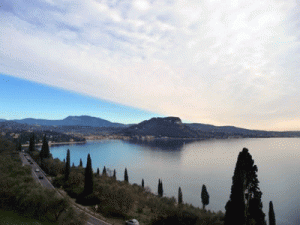Garda lies at the centre of a magnificent gulf,
with arched shores protected, to the north, by the slopes of Mount Baldo, to the south by the Rocca (rock) and to the east by the morainic hills.
Garda is among villas and olive groves, the Gardesana road connects the town with Punta San Vigilio, one of the most romantic resorts on the lake. The town, of very ancient origins, still preserves parts of its medieva traits, with remains of towers and walls, despite the urban developments. From Garda one can reach the village of Spiazzi di Monte Baldo and go to the famous shrine of Madonna della Corona (Our Lady of the Crown).
TERRITORY OF GARDA
Fractions:
Surrounding municipalities: Bardolino, Costermano, Torri del Benaco
Altitude: 67 m s.l.m. – Population: 3.980 – inhabitants name: gardesani
HISTORY OF GARDA
Traces of prehistoric settlements from the Neolithic period have been found on the Rock, while his feet were found piles and the age of the tools bronzo.Nel 1964 he found a necropolis with the discovery of nineteen tombs, vases, bowls and carved bones, the Monte Luppia over San Vigilio, were found petroglyphs with warriors, weapons, knights and animals, similar to those found in Valcamonica; thus began a systematic search for these, which were called “engravings of Garda.” From Roman time is greater the number of pieces than the informations from that, several have been found on top of the fortress, on the beach and in the square of the parish church, fragments of buildings came to light again in 1662 to lay the foundations for “eremo dei Camaldolesi“, a memorial stone was then used to create a fountain, a plaque in the chapel of the parish church. At the base of the fortress were also found traces of a temple dedicated to Fortuna and Victoria, as the statues and a stone altar. Garda became very important political and military in the Middle Ages, after Charlemagne in 768 elevated him to County. There were four castles to protect Garda, one was at the top ofthe Rocca (the most important), one was in town Castei, and the last one to Castion Marciaga. From that period Garda gives its name to the lake formerly called Benaco. In 951 Queen Adelaide di Borgogna had been held captive on the Rock. The events of the fortress are many, are linked to those of Otto of Wittesbach, founder of the house of Bavaria and the Bishop Albert of Trent until 1209, when Otto IV toltala the city demolished it. The lake was under the control of the Venetian Republic from 1405 to the arrival of Napoleon, during which time the Garda was divided into four districts: the “Magnifica Patria” (current Brescia Riviera), the “Sommolago” (Riva and Torbole), with the fortress of Peschiera its appurtenances and for the last “Gardesana dell’Acqua” (eastern shore). Some memories are left in the Venetian Palazzo dei Capitani and some folkloric traditions such as the Feast of St. Mark and the races of bisse. Many stories and legends of Garda have been summarized in the famous verses of Carducci, you think that we be married Teodolinda, the first of his queens barbaric.
TYPICAL PRODUCTS OF LOCAL CUISINE
Lake fish of Garda lake, wine Bardolino, Extravirgin Olive oil of Garda lake dop,

